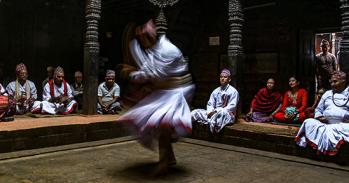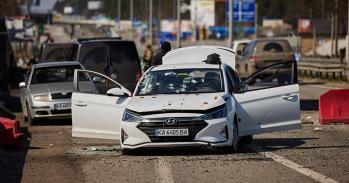A major project – Where Rising Powers Meet – looks at life along the border that separates Russia, China and Mongolia. Among the researchers involved is Dr Sayana Namsaraeva whose work focuses on the experiences of the Buriad ethnic group to which she belongs.
A major project – Where Rising Powers Meet – looks at life along the border that separates Russia, China and Mongolia. Among the researchers involved is Dr Sayana Namsaraeva whose work focuses on the experiences of the Buriad ethnic group to which she belongs.
My experience of living in Russia through the 1990s made me aware of how, in the absence of the state, what really mattered were human relationships.
Sayana Namsaraeva
Every two years thousands of people travel from towns and villages throughout northern Asia to attend a festival called Altargana that is held in one of three countries – Mongolia, Russia and China. The event is an important landmark in the lives of many of the region’s 0.5 million Buriad (or Buryat) people. For the space of a few days the usual visa regulations are waived and people from a radius of 1,000 miles or more are allowed to pass through national borders to meet and renew their connections as an ethnic group.
YouTube clips of Altargarna feature hauntingly beautiful music played on traditional instruments. But underneath the folk songs and displays of national dress lies a deep sense of trauma felt by a people who have over the past century suffered several eras of persecution and enforced relocation. The stress of being uprooted and separated has left its mark on ethnic identity and further complicated the notions of homeland for semi-nomadic people whose way of life has for centuries focused on the herding of animals across many hundreds of miles of rolling pasture.
The territories that are today home to the Buriad people lie on either side of the easternmost section of the world’s longest border which stretches from the Caspian Sea in the west to the Sea of Japan in the east. As a divide separating powerful nations, it has witnessed some of the most radical political upheavals in modern world history: the rise and fall of the Soviet Union, the iron grip of communism in China. Like dozens of other ethnic groups, the Buriads were caught up in the brutality of extreme ideologies and, when they resisted the imposition of changes from the outside, thousands of people were sent to slave labour camps or summarily executed.
This 2,500-mile long border - and its social, economic and political significance to the people who live on either side - is the subject of a major study currently being undertaken by Cambridge University’s Mongolia & Inner Asia Studies Unit (MIASU). ‘Where Rising Powers meet: China and Russia at their north Asian border’ is directed by the distinguished anthropologist Professor Caroline Humphrey. The team of researchers involved in the project is coordinated by Dr Franck Billé, whose research focuses on urban developments and contrasting forms of modernity in two cities of Heihe (China) and Blagoveshchensk (Russia) that lie opposite each other on the boundary Amur River.
Among the non-British researchers contributing to the project is the anthropologist Dr Sayana Namsaraeva. She was born into a Buriad family in Aginskoye in Siberia, a town that is home to one of the largest Buriad communities. From the age of six she was educated in Moscow, some 5,000 miles away, where her parents were working and returned to her grandparents in Siberia for the long summer holidays. “My grandparents were teachers but they also had a farm. I helped to milk the cows, I learnt how to make hay and I went with the other children to gather berries in the forest,” she says. “In Moscow I attracted attention as the only Asian child at my school. I quickly made friends but it was an early education in ethnic differences and it made me curious about people and how they saw each other.”
Dr Namsaraeva took her first degree in Oriental Studies at the University of St Petersburg and went on to take a PhD at the Institute of Oriental Studies in Moscow, where she began to shift her approach from that of an historian to that of an anthropologist. She later joined the Max Planck Institute for Social Anthropology in Germany where her post enabled her to explore through fieldwork the experiences of Buriad communities within the space of the Russian-Chinese frontier lands and, in particular, piecing together the multi-generational stories of families whose lives reveal just how complex relationships are when political borders mismatch with ethnic boundaries.
She says: “My own experience of living in Russia through the 1990s, with the collapse of the Soviet Union, made me aware of how, in the absence of the state, what really mattered were human relationships and, in particular, kinship ties which enabled people to access vital supplies such as food and gasoline. I also saw how, when the state had failed and salaries were not paid, families became stronger units and three generations would rely on the retirement pensions of the grandparents. It made me think about the bonds that hold groups together and the pressures that pull them apart.”
For the next three years Dr Namsaraeva will be based at MIASU where her life experiences, knowledge of the region, and grasp of Mongolian and Buriad languages (in addition to Chinese, Russian, German and English) will bring an invaluable dimension to the Rising Powers project. Like Dr Billé, she will look at two border cities - Manzhouli in China and Zabaikal’sk in Russia – and will explore the ways in which the communities living and working in these places are forming social, cultural and trade networks.
Although she is proud to describe herself as a Buriad, Dr Namasaeva stresses that her higher education and academic career have in many ways distanced her from her early kinship ties, meaning that her experience as an anthropologist working in the field within the dispersed Buriad communities makes her not so different to other outsiders, while bringing with it an extra sense of emotional involvement. “During my fieldwork I found myself talking to older members of the community who had hidden their pain for decades. I was discovering the recent history of my own people,” she says.
“When people are forcibly displaced from their homeland, there’s a strong desire to go back and reclaim lost lands and, just as importantly, to visit the local places of worship linked to birth and death. However, it’s different for the second and third generations who feel at home where they are born. Thus Buriads in Russia have become ‘Russified’ and those in China have become ‘Chinesified’. When this process intersected with hostile Russian-Chinese relations, there was ample scope for tension and suspicion – but gradually these differences have become accepted and are even celebrated at festivals such as Altargana.”
One strand of Dr Namasaeva’s recent work has looked at the complex Buriad notion of home, or nutag, with reference to understandings of home within both the kin majority (largest group) of those who stayed in their villages in Siberia and within those people who dispersed, either voluntarily or forcibly, to form diasporas and isolated communities throughout northeast Asia. Nutag is embedded in the traditional Buriad lifestyle of herding animals, in which families migrate between pastures according to the season. The word means grazing land rather than simply dwelling place or settlement. In this sense, nutag has a flexible meaning while being deeply connected to the landscape and its importance in sustaining life. Nutag is also linked to Buriad spirituality of which stone cairns, or oboos, are the physical markers of places were local spirits are invoked in return for good and safe grazing.
Research by Dr Namasaeva illustrates the damage done when borders are sealed in such a way as to cut across ethnic homelands. For several decades, these rigid divides prevented people from making visits not just to their own kin but also journeys to places of worship and places of birth, thus denying them aspects of their lives that they held dearest. She says: “In diaspora tales, the deeply unsettling experience of life in exile is described as life on the ‘wrong side’ and done in the ‘wrong way’: as if they milk cows from the wrong side or saddle and mount horses also from the ‘wrong side’.”
Today a population of around 445,000 Buriads form the largest ethnic minority group in Siberia where most live in the Buryat Republic, a federal subject of Russia. A further 42,000 Buriads live in Mongolia and some 7,000 live in Inner Mongolia (China). The opening of the national borders that for many years separated these people has ushered in a new era of freedom of movement, whether in terms of renewing family ties or pursuing educational and economic opportunities.
The lifting of restrictions has very different resonances across the generations. Older people carry with them a sense of displacement that will undoubtedly have a legacy in the memories of their children. On the other hand, uncertainty about notions of homeland is not so important for the diaspora second generation who did not themselves experience forced relocation. “Transborder mobility is perceived more as movement between different segments of one large homeland, where everyone is free to return to one’s chosen encampment,” says Dr Namasaeva. “This situation recalls the way things were before borders went up, when nutag was not dissected by lines of separation.”
For more information on this story contact Alex Buxton, Communications Office, University of Cambridge, alex.buxton@admin.cam.ac.uk 01223 761673
This work is licensed under a Creative Commons Licence. If you use this content on your site please link back to this page.





